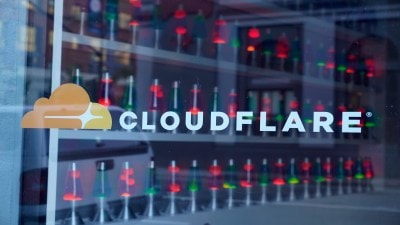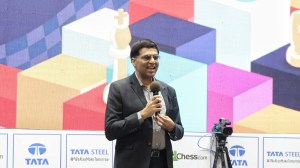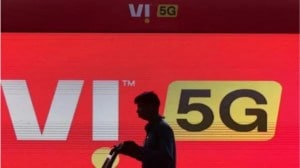In J-K this time, the question of power has another aspect: Electricity
With the UT suffering long power cuts, now as much in Kashmir as Jammu – and solutions not easy – promises around electricity rank high in manifestos of all parties
 Prime Minister Narendra Modi inaugurated that Baglihar Hydro Electric Project in J&K in 2015 (Photo: Ministry of Information and Broadcasting)
Prime Minister Narendra Modi inaugurated that Baglihar Hydro Electric Project in J&K in 2015 (Photo: Ministry of Information and Broadcasting)One of the proud proclamations of Lieutenant Governor Manoj Sinha used to be that, after the abrogation of Article 370 by the Centre, people of Jammu and Kashmir were seeing “barf and bijli (snow and electricity)” together for the first time – referring to the long power cuts in winter that have been long the norm in J&K which, he declared, had been ended.
As the erstwhile state sees its first Assembly elections after the abrogation, it is that failed promise that ranks up there along with issues of identity and political representation that have long roiled J&K. Many believe the two are intertwined, with J&K’s power projects seen as “under the control of the Centre”, aggravating the crisis arising from low generation of electricity, and making power cuts lasting around three hours a day the norm even in summer months, apart from winter.
Manifestos of all political parties in the race this time, regional or national, feature promises around electricity. The issue was raised by Congress MP and Leader of the Opposition Rahul Gandhi last week at the first major rally by alliance partners National Conference (NC) and Congress in J&K.
While regional parties have promised the “return” of hydropower projects to J&K’s control, the BJP says its government would enhance power-generation capacity.
The crisis
Since a majority of electricity generated in J&K is from hydropower sources, the capacity depends entirely on river flow, which is in turn governed by precipitation of snow. J&K does not produce thermal power, and solar power contributes only 20 MW a year as of now, with the administration setting a target of producing 100 MW.
Even as recently as 2019-2020, the UT incurred losses through distribution for 65% of its supply. Revenue from metered connections only accounted for about 35% of J&K’s power supply, with the rest reliant on additional budgetary support. Nearly half the consumers in J&K do not have metered connections.
That is one aspect of the problem.
For J&K, what is more of an issue is the fact that out of an installed capacity of 3,500 MW, only 1,200 MW is administered by the UT itself while 2,300 MW is through the National Hydroelectric Power Corporation (NHPC) plants which also feed into the national pool.
Among the biggest power projects in J&K is the Baglihar plant, with a generation capacity of 900 MW. The remaining 300 MW comes from smaller local projects.
In June and July, the height of summer, the generation capacity peaks, with UT sector projects said to produce 1,050 MW and the NHPC projects over 2,000 MW. But the actual generation is lesser.
In peak winter, generation is much lower, with all projects adding up to 600-650 MW since the rivers powering the hydro plants freeze in sub-zero temperatures. In this period, peak demand is about 3,600 MW.
Jammu generally has a higher demand than Kashmir in the summer, and vice-versa in the winter.
To meet the deficit, the UT administration has Power Purchase Agreements in place with the NHPC, the National Thermal Power Corporation (NTPC) and a 70-MW deal with the Nuclear Power Corporation of India (NPCI). But the strained exchequer means there are budgetary restrictions on buying power from the national grid. In the 2023-24 financial year, the J&K administration spent Rs 9,886 crore in buying power.
The low metered connections further restrict the ability of the exchequer to make up its limited resources. Which is why the administration had made consumer metering its priority, saying that in order to provide electricity for longer hours, it will need to charge consumers. However, attempts to raise electricity prices have led to several protests over the last three years.
J&K Power Secretary H Rajesh Prasad points out that the UT has one of the lowest power tariffs in the country. “Our average domestic tariff is about Rs 4 per unit. The average tariff nationally is above Rs 8.”
He says one of the routes the department uses is restricting peak demand. “If peak demand is 3,500 MW, the department tries to supply about 3,200 MW.”
Last December, the long power cuts during the 40-day peak winter in the Valley, had seen both the Kashmir Power Distribution Corporation Limited (KPDCL) and consumers taking to social media to target each other. The power discom first intensified household checks and began naming-and-shaming residents for using coil heaters in huge overhead tanks, or hooking and bypassing meters, or deploying other methods of pilferage, in an effort to stigmatise power theft.
The consumers replied by criticising the department for failing to provide adequate electricity.
The promises
Given the ground reality, and the resistance to electricity meters that has often resulted in protests, no party is promising the ideal 24-hour power supply. Almost all are promising varying amounts of free units per month.
The NC, the first to publish its manifesto, promised free electricity up to 200 units, apart from the transfer of central hydropower projects to the UT. The party also promised one-time settlement of pending electricity bill arrears. For the remote corners of the UT, the party stated it will encourage people to invest in mini-hydropower projects.
The Peoples Democratic Party (PDP) manifesto is almost the same on this issue: “transfer” of all hydropower projects to J&K, free electricity up to 200 units to every household, and one-time settlement of pending bills.
The People’s Conference in its manifesto has committed itself to free electricity for families living below the poverty line and for those living in catchment areas surrounding power projects.
The Apni Party has promised 500 units of free electricity alongside an 80% employment quota for local youth in under-construction hydropower projects in J&K.
Among the national parties, while the Congress is yet to release its manifesto, the BJP has promised an increase in the hydropower generation from 3,500 MW to 5,000 MW through micro-hydropower projects in feasible districts. “Further, we will work with the Centre to ensure that pending royalties on hydroelectric projects are settled on time,” the BJP manifesto stated. The party does not promise free power or the “return” of power projects to J&K.



- 01
- 02
- 03
- 04
- 05




























